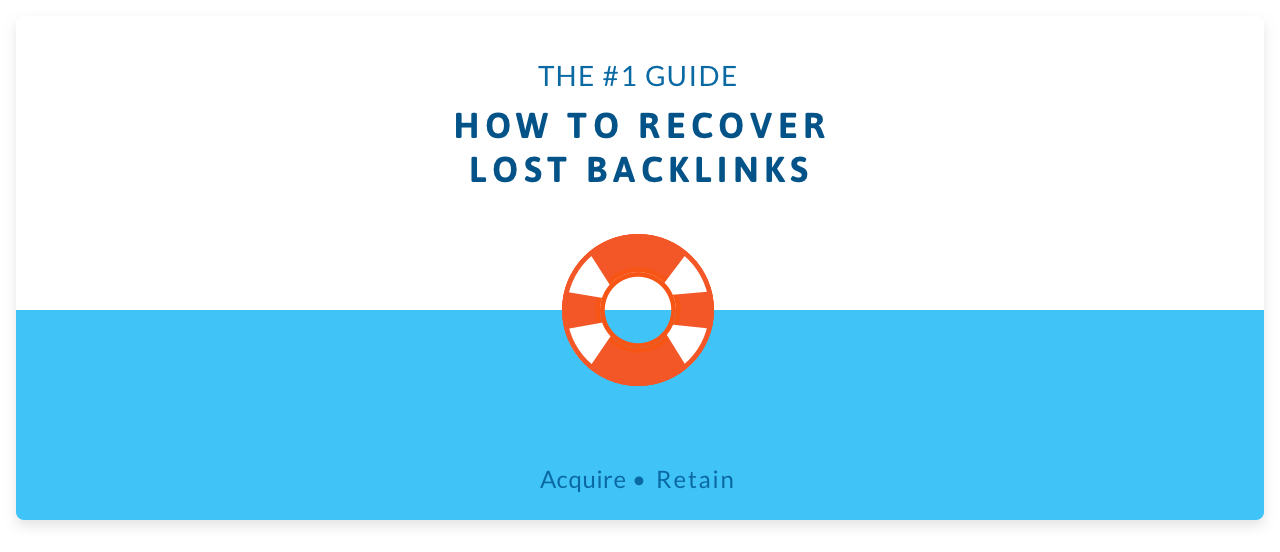
How to Recover Lost Backlinks – The #1 Guide
This guide explains how to recover backlinks with or without our tool (we built Backlink Recovery to help you automatically recover lost backlinks). From monitoring your websites lost backlinks, and evaluating whether you can recover them, to the steps required to help you quickly and systematically reclaim them on an ongoing basis.
Websites lose links regularly. Very regularly. Recovering these lost links is the most sustainable white-hat link building tactic we know of. It’s scalable and only costs you a bit of your time.
Backlink recovery makes sense because the conversion is so high. If a website was already linking to you, and the link has been removed (usually unintentionally), it’s likely that they will link to you again.
But you know what the thing is? Not many SEOs or digital/growth marketers even think about keeping the links they already have.
Let’s imagine that your website is acquiring 50 new links a month and losing 20, you’re putting so much effort into link building, but almost half of that is going to waste. That’s why we truly believe in the importance of backlink recovery.
So… why do websites lose links?
When people update their websites, which happens all the time, they inevitably modify content. They might add new content, merge content, unpublish content, or even re-design the entire website itself. Every time they do this, there’s a high chance that you’ll lose a link. Your backlink is their collateral damage.
The most common reasons why websites lose links are:
- The link breaks, resulting in a 404.
- The content containing your backlink has been modified and your link has gone.
- The website underwent a redesign and many links were unpublished, including yours.
- The backlinking site is under new ownership, and has been redirected at the domain level, resulting in a lot of lost links.
There are a many, many more reasons as to why a link might disappear, but the most important thing is knowing when it happens, and how to get them back.
Why does backlink recovery work?
Great marketing strategies are built on two things: acquisition and retention.
It’s a common myth that fast-growing websites drive growth through rapid customer acquisition alone. This is almost never the case. Retention is always the underlying driver of growth.
Link building is no different, it too requires a focus on both link acquisition and link retention. In our experience, 90% of SEOs do link acquisition, but only 10% are actively running link retention activities.
Yet, every website loses links.
And when they do, it looks something like this:
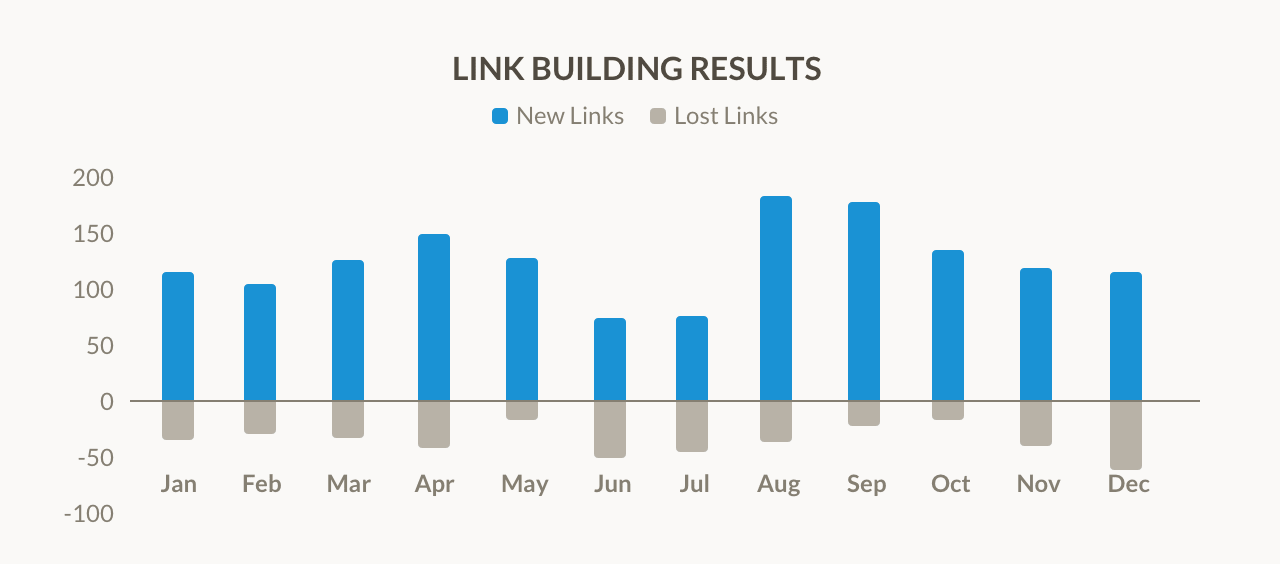
See the orange bars? In this example, the website has gained a total of 1,517 new links in the 2019 calendar year and lost a total of 427. So, the total number of new links gained is 1,144 for the year. Far fewer than what it originally seemed.
That’s over 30% of their total links lost in one year alone. This is pretty normal.
Is it easy to get the backlinks reinstated?
It sure is.
By just doing a small amount of work to at least try and get some of these backlinks back, you are already doing more than most other websites. So, you’ll likely get seriously good results. I’ve seen conversion rates higher than your average email open rate.
Why? Not only is it because you’re prepared to do something very few other SEOs are even thinking of, but also because you might actually be helping the people running those websites.
Think about it, they just updated their website, and you, a genuinely concerned citizen of the Internet are helping them identify missing content on their website. You’re too kind, 😉.
How link recovering effects your SEO results
Back to our earlier example, where the website lost 427 links because they weren’t doing backlink recovery, let’s have a look at what the difference would have been if they were doing backlink recovery over the same 12-month period:
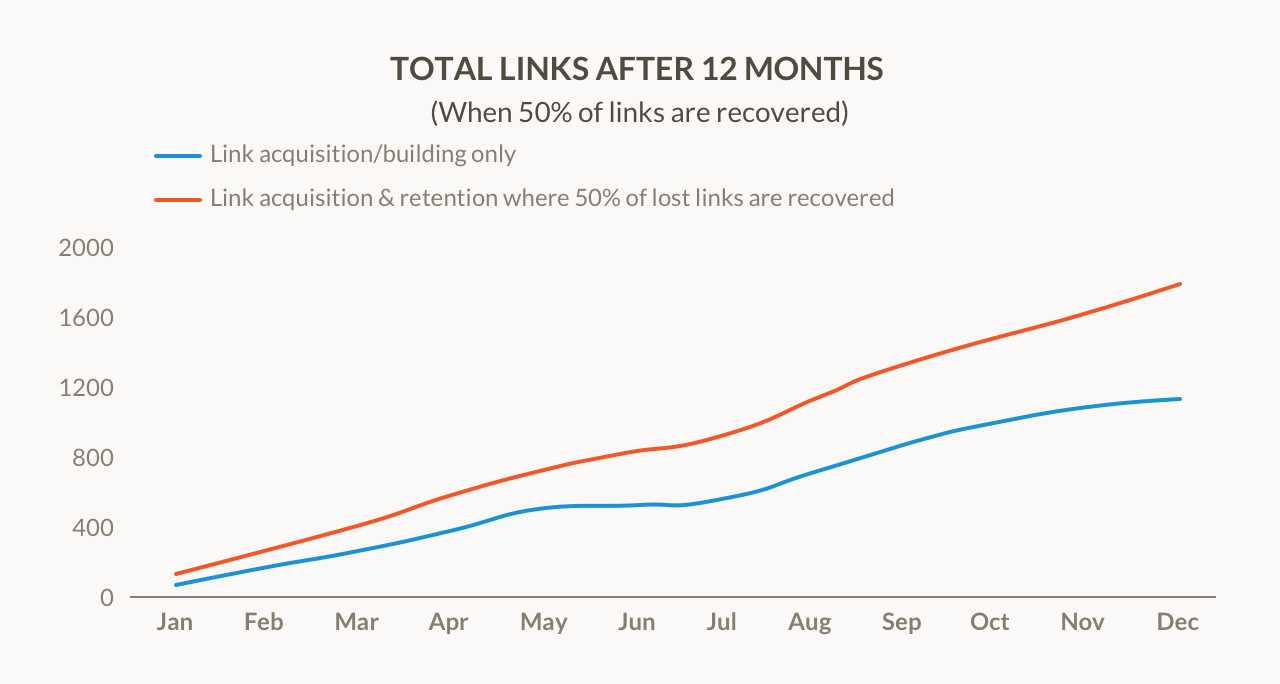
In a scenario where the website regains 50% of their lost links, they would have a total of 640 more links in the same 12-month period!
That’s the equivalent of an extra four months of link building. Pay rise here we come.
Even in a worst-case scenario where they might only manage to reinstate just 20% of those lost links, they would still end up with 85 more links than would have otherwise.
So, as you can see, the best-case scenario is that you get more links, and the worst-case scenario is that you get more links. Sounds like a good SEO strategy to me.
If you are wanting to implement link-retention in to your day-to-day SEO routine, there are two things you’ll need to focus on:
- Getting your lost links reinstated, this is known as backlink recovery.
- Ensuring every mention results in a link, this is known as link reclamation.
Backlink recovery is the process of identifying former linking domains (websites that used to link to you but no longer do) and actively working to have those lost links reinstated.
Link reclamation is the process of identifying potential opportunities for links, such as brand mentions, reproduced images or content and asking the hosting website to provide you with a backlink to your domain (attribution).
Guide Overview
This comprehensive guide to backlink recovery is written by SEOs who take their content marketing seriously and have mastered the art of writing 3,000-word articles that keep you reading until the very end.
Without wasting your time.
This guide is separated into three parts:
- How to identify lost backlinking domains
- How to prioritise backlink recovery
- How to recover the lost backlinks
Part one: how to identify lost linking domains

Like most things in the SEO world, it all starts with an expensive SEO tool… (😆 with some free alternatives).
All you need to have is a way to regularly generate a list of lost backlinks.
There are many resources for this, some paid and others free. Starting with the paid ones (in case you already pay for these). You can download a list of ‘lost linking domains’ from the following tools:
Some of these tools will only include data from the date you added your website to the tools, but others can provide a historical record of lost backlinks.
In a scenario where you’re not using these paid tools, the best, most comprehensive record of lost links to your domain can be obtained from Google Webmaster Tools (GWT) itself. I’m not going to lie, it’s definitely harder and certainly takes longer. But it does work.
How to generate a list of lost linking domains using Google Webmaster Tools (GWT)
- Login to GWT and navigate to the ‘Links’ tab (in the new interface).
- Navigate to the ‘Top Linking Sites’ report in the second-tier menu.
- Open the CSV up in Google Docs
- Wait 30 days (or use Backlink Recovery if you don’t want to wait)
- Come back to GWT and repeat steps 1 to 3 (download the same report again). By comparing these two reports, we will be able to identify the potentially lost backlinks over the past 30 days.
- Open the second CSV up in the original Google Docs spreadsheet, and copy all of the results in to a new sheet.
- Return to the first sheet (links from 30 days earlier), in column B add the following formula: =IF(VLOOKUP(‘A2’,’!Sheet2A:Z’,’TRUE’),”Active link”, “Lost link”)
- Copy the formula down the column so that it checks for every row.
- Filter out the rows with the value “Lost link” and copy them to their own spreadsheet.
Here’s a video demonstration of how to do this (coming soon).
Obviously, this is a rather slow-stream way of discovering lost backlinks. But it does work. The biggest upside of this method, and it’s a big upside, is that because the source of lost linking domains is GWT, it’s a true representation of the backlinks that Google actually values for your website (because they’ve indexed them).
There are a few downsides though, the biggest being that it’s not necessarily a comprehensive list of the links Google knows about, nor is it the definitive list of links pointing to your site. Further to this, the timeliness of your outreach is also hindered as it could take you up to a month to actually contact the lost linking domain owner or writer. This might reduce their likelihood of reinstating the link.
Lost linking domains or lost links?
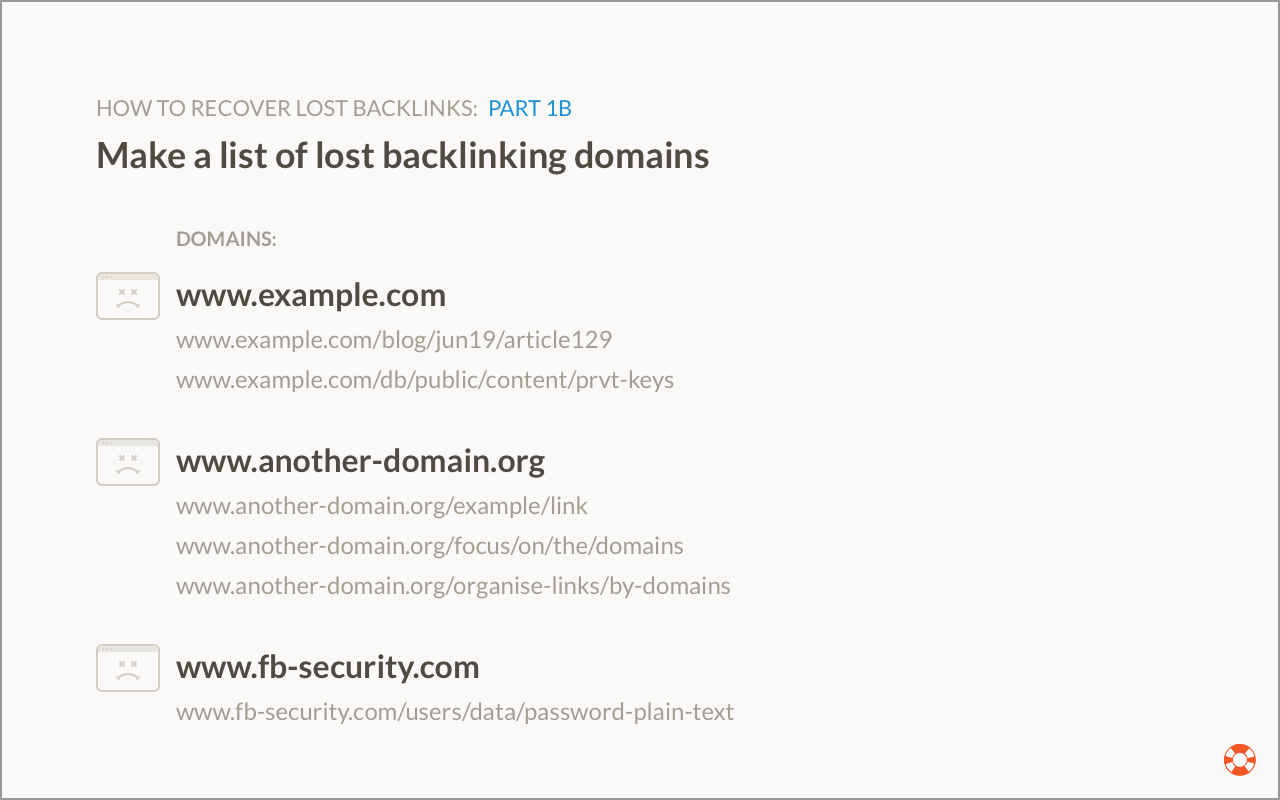
Domains, not links. For every lost linking domain your site has, you probably have many different incarnations of that same link being lost elsewhere on the domain. As such, and to keep your work load down, we want to limit lost links to one link per domain. Or, as it is technically known ‘lost backlinking domains’. This is important.
Nonetheless, let’s move on.
Regardless of how you’re getting your list of lost links, you’re now ready to evaluate them and work out which ones are worth recovering.
Part two: how to prioritise backlink recovery
Not all links are worth recovering.
In fact, you might be happy that some have disappeared, especially if you’re disavowing dodgy links. Other examples of links that are not worth your time trying to recover may include:
- Forums,
- Review sites,
- Scenarios where the link sits peripherally to the content (e.g. a comment/author bio)
These links are difficult to recover because it’s hard to work out how it got there, and who put it there. This in turn makes it difficult for the person you plan on contacting/asking to reinstate it. As a general rule, any lost link where the bulk of the site is user generated content can be tricky (and I personally try to avoid it). You’ll need to manually filter these out. However, if you’re using the Backlink Recovery app, we will do this for you.
Now that you have a true list of the lost links, you will want to enrich the website data to determine the value of those lost link. You can do this by looking up the domain in Open Site Explorer or visiting the domain with one of many SEO extensions turned on. You can determine the value of the link using industry standard measures of authority, such as:
- Domain Authority
- Page Authority
Once you’ve obtained each of these metrics for your lost linking domains, you can start removing links you don’t think are worth attempting to recover.

Removing links that are not worth recovering
This is an important step, as it’s going to determine how much work you do in stage three (outreach). Without being too ruthless, you’ll want to remove any link that you genuinely think you won’t be able to recover.
To help you do this, you might want to run the domain through any number of the following audits, checks or filters:
Visit the website
- Does it look dodgy?
- Does the domain still resolve?
- Is it redirecting, potentially suggesting a change in ownership? Or cloaking?
- Is it 404ing, perhaps it’s been unpublished?
- Is the domain still relevant? If not, do you still want the link?
Identify the linking page
- Can you find the exact page where your link used to be?*
- Is the content still on the site?
- If you can find the page, inspect the source code and try and find (with a simple ctrl+f search) any reference to your domain.
- When was the link first published?*
- Can you determine the content on your site that they were originally linking to?*
Determine the quality of the link
- A website’s purpose can change over time, is the website still relevant?
- Even if it’s not, could you get a relevant link? (For example a cafe linking to a local bus app is relevant enough—in my opinion). Heck, I’d take most links I can get though.
- Do you have a minimum DA or PA, say 3 or 4, that you want links from?*
- When did you lose it? You might need to use the Way Back Machine to determine a link lost date.*
Ease of recovery
- Can you easily find the right person to contact at the organisation?*
- How likely, assuming they receive your email, are they to action it?
- Can that person actually make the necessary changes to the website?
* The Backlink Recovery tool does these things for you.
After you’ve completed the above steps, it’s likely that your original list of lost backlinks has been reduced by about 30%. These remaining links are now prime targets for recovery. The next step is asking for the links to be reinstated.
Part three: recovering the lost backlinks
Now comes the fun part: getting the links back. There’s no fancy tricks or hacks here, just very cleverly worded and highly targeted emails.
Finding the right person to contact really matters.
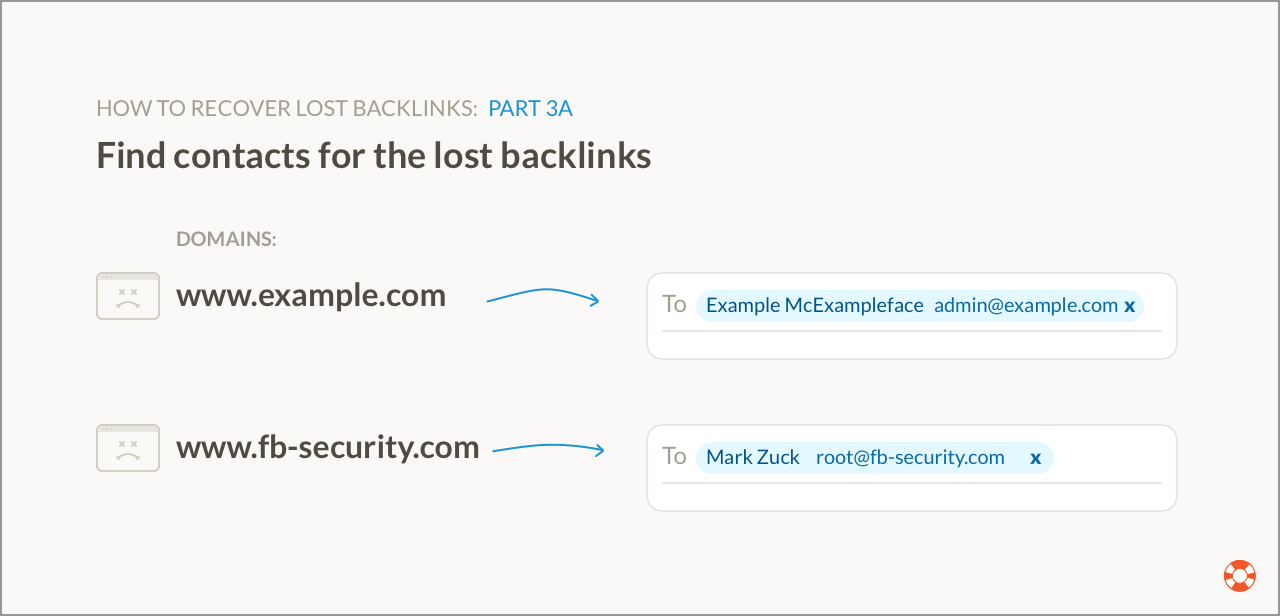
If you already know the right people to contact at the backlinking domain, then add their name and email to your spreadsheet.
If you don’t know the right person to contact, consider checking their website. The easiest starting point is to see if you can identify the author of the content. This works really well for local or industry news websites. Sometimes the author’s email address will actually be printed on the page itself.
If this is not the case, you’re going to have to resort to trying to find the person’s contact details through the champions of privacy, your friendly Interwebz tools like Hunter. These tools will help you quickly find potentially relevant email addresses and their position title.
It will return a list of all known email addresses at the domain. You’re going to want to carefully select people with titles like these:
- Publishing
- Content Manager
- Author
- Writer
- Marketing
- Engineer
- Website Manager
- I.e. people who can actually update the website.
It’s very unlikely that you’ll strike gold by randomly stumbling across the very person responsible for the content in question, but that’s not really the point at this stage. No, the point is to select someone who knows the right person or is accountable enough to forward it on to them. Just something to find your way in.
Carbon Copy Cheat
A nifty little growth-hack at this point of the process is carbon copying (the CC line in your email) one or two other people in. This creates epic levels of accountability for all parties and will likely trigger one of two responses. Either the lowest ranked person in the chain will action this to keep it off the desks of the people above. Or, one of them will forward it to the right person/department. No one is going to reply-all with dopey responses like “what website?” or “I don’t know what you’re talking about”. But if they do, at least you’ll get a response.
High conversion email templates for backlink recovery
Email outreach, if you’re not aware, is the practice of spamming people on the Internet until they either link to you or delete their email address. Usually out of fatigue or hope that by linking to you the emails might stop, or sometimes because they simply feel sorry for you.
This is not the kind of email outreach you want to do. Noooo, not at all. Do not do this. This step is the most performant component of the entire backlink recovery practice. A high-quality outreach program will get your links back.
Example templates
Remember, these people already know you, they were linking to your website until just recently. Your emails should be personable, not random with calls-to-action everywhere. They should be written by real humans, for real humans. For example…
Example 1
To: Neil Patel
CC: Rand Fishkin
Dear Neil, I hope you’re going well? Just a quick one here.
I’m not sure if you’re aware, but you recently deleted a link on your website to a piece of content on my site. I only noticed because we were actually getting a fair bit of traffic from the link, so I’m emailing to see if we could get it reinstated please?
The link was on this post on your website (the best tool on the internet), and it was pointing here: https://www.backlinkrecovery.com/.
Thanks so much,
Will
Marketing Manager at Backlink RecoveryExample 2
To: Seth Zinke
CC: Sherry Collins
Dear Seth,
I hope all is well? I manage the content at www.kremlin.ru where we’ve been getting a fair bit of traffic from your domain since about May 2017.
It was largely due to this this popular piece of content on your website. I noticed you removed the link to our site last week, and I wanted to see if we could please get it back?
Let me know if you need any more information to make this happen?
Best,
DarrellExample 3
To: Theresa May
CC: Nigel Farage
Hey Theresa,
I hope your day’s going well?
Just a quick one. You unpublished a piece of content last week, and in doing so seem to have removed a link you had to my website.
I wouldn’t normally send an email asking about this as it’s not normally a big deal, but we were actually getting quite a lot of referral traffic from that post.
The link was on this page: https://www.brexit.co.uk/the-lies and it was pointing here: https://www.leavers.co.uk/the-truth.
Thanks so much,
Boris
Community Engagement Officer at Mayor of LondonYou’ll also want to ensure you actively follow up on each email (ensuring it’s opened and actioned). (Our Backlink Recovery tool automatically does this for you too.)
Running your outreach
We’re up to the final step, sending the emails. You have a few options here, and one of them is definitely not mail chimp. My tool of preference would be Sujan Patel’s Mailshake. Mailshake is a really simple email outreach tool, and one of its best features is the fact that it enables you to send email from your own Gmail inbox.
Alternatively, you can use your own email account to manually send them. Although this is not recommended as it will get very hard to manage the follow up.
The Backlink Recovery tool also performs this function too. It will send the emails on your behalf so that when people reply, the responses come directly into your inbox. It will also automatically schedule follow up with the prospects to ensure they action it.
Conclusion
Of course, this wouldn’t be the epic piece of content marketing it is, if I didn’t encourage you to start using Backlink Recovery. Why? Because it does all of this in a matter of seconds, and only costs a couple cents per attempted link recovery.
Another great reason to sign up, is that it will give you a list of the backlinking domains you’ve lost in the past 12 months, meaning the fact that you’ve only started doing this now, doesn’t mean you’ve lost the opportunity from the past 12 months.
Click here to get started with Backlink Recovery, plans start at $13 per month and you can cancel anytime, such as when you shut down your website or have enough backlinks and don’t want any more.